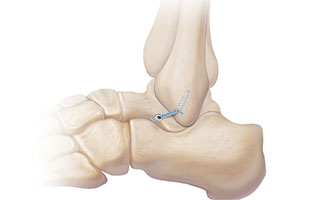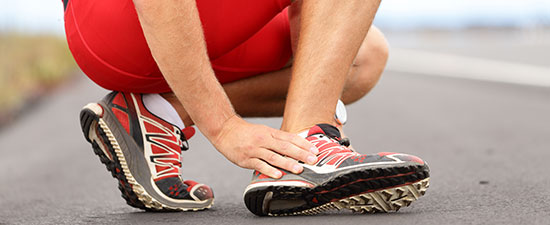- Home
- Advanced Treatments
- InternalBrace for Chronic Ankle Instability
InternalBrace for Ligament Repair
- Published 11/26/2018
- Last Reviewed 2/7/2024

An ankle ligament injury is one of the most common sports injuries. Straining, overstretching, partially tearing, or rupturing a ligament are all examples of ankle injuries that can occur from traumatic ankle events or overuse.
Suddenly rolling your ankle or the repetitive side-to-side movements of sports such as basketball put stress on the lateral ankle ligaments. Surgical repair is generally required when conservative treatment doesn't resolve a ligament injury.
- What is the InternalBrace?
- Why choose InternalBrace for the treatment of chronic ankle instability symptoms?
- How does the InternalBrace improve upon traditional treatments?
- InternalBrace: a faster and stronger recovery
- UFAI doctors have experience with InternalBrace procedures
- InternalBrace FAQs
- What is the recovery time for InternalBrace surgery?
- What is the difference between InternalBrace and Brostrom procedures?
- Can a Brostrom procedure fail?
-
ABFAS® Board Certified in Foot Surgery and Reconstructive Rearfoot and Ankle Surgery. and Director of University Foot and Ankle Institute
Dr. Bob Baravarian DPM, FACFAS is a Board-Certified Podiatric Foot and Ankle Specialist. He is an assistant clinical professor at the UCLA School of Medicine and serves as Director of University Foot and Ankle Institute.
Dr. Baravarian has been involved in athletics his entire life and played competitive tennis in high school and college. He has an interest in sports medicine, arthritis therapy, and trauma/reconstructive surgery of the foot and ankle. He is also fluent in five languages (English, French, Spanish, Farsi, and Hebrew),
-
ABFAS® Board Certified in Foot Surgery and Reconstructive Rearfoot and Ankle Surgery. and Director of University Foot and Ankle Institute
Dr. Bob Baravarian DPM, FACFAS is a Board-Certified Podiatric Foot and Ankle Specialist. He is an assistant clinical professor at the UCLA School of Medicine and serves as Director of University Foot and Ankle Institute.
Dr. Baravarian has been involved in athletics his entire life and played competitive tennis in high school and college. He has an interest in sports medicine, arthritis therapy, and trauma/reconstructive surgery of the foot and ankle. He is also fluent in five languages (English, French, Spanish, Farsi, and Hebrew),
More Chronic Ankle Instability articles from Our Blog
 Second to none!Bob N.
Second to none!Bob N. Please provide handicap parkingBarry S.
Please provide handicap parkingBarry S. Dr. Gary Brisken has been my doctor going on two years. He's a very kind and thoughtful physician. The heath of my feet has imp...Mark P.
Dr. Gary Brisken has been my doctor going on two years. He's a very kind and thoughtful physician. The heath of my feet has imp...Mark P. Dr. Ambibola Johnson is awesome!Laurie S.
Dr. Ambibola Johnson is awesome!Laurie S. I appreciate the care and timeliness of all my appointments I’ve had at UFAI. Gray, Lydia and the staff all are wonderful. Lydi...Edelmira G.
I appreciate the care and timeliness of all my appointments I’ve had at UFAI. Gray, Lydia and the staff all are wonderful. Lydi...Edelmira G. Very greatfull for the doctor and stuffJesus M.
Very greatfull for the doctor and stuffJesus M. I just got back from playing tennis, my favorite activity and I have Dr. Baravarian to thank!
I just got back from playing tennis, my favorite activity and I have Dr. Baravarian to thank!
I have a long back story. I frac...Em M. Doctor was very caringBrigitte S.
Doctor was very caringBrigitte S. Everyone is very nice and efficient-
Everyone is very nice and efficient-
Especially Dr Kelman. He takes very good care of me!!Claudia K. Great costumer service.
Great costumer service.
Prompt and efficientDean W. No . I’m pleased with the care .Michael P.
No . I’m pleased with the care .Michael P. Appreciate the professionalism and expertise, as well as the caring.Stella G.
Appreciate the professionalism and expertise, as well as the caring.Stella G.


